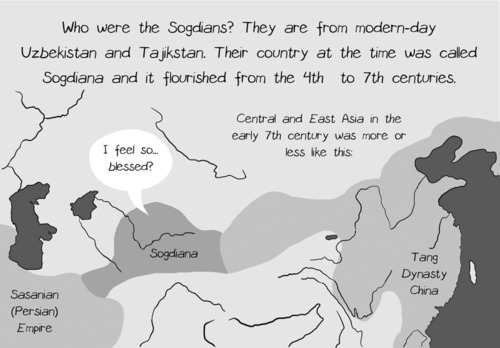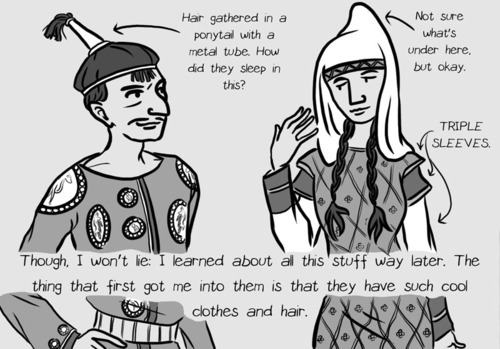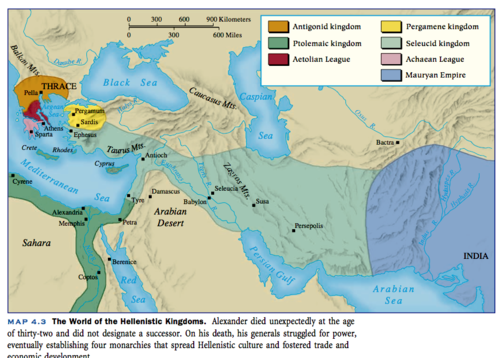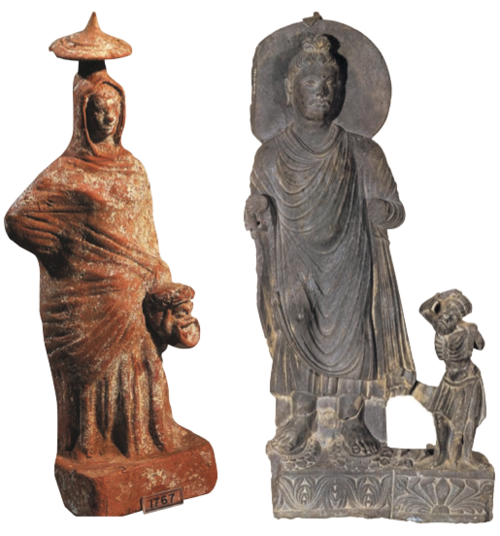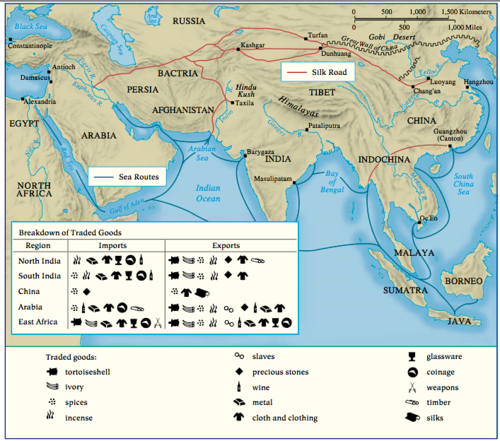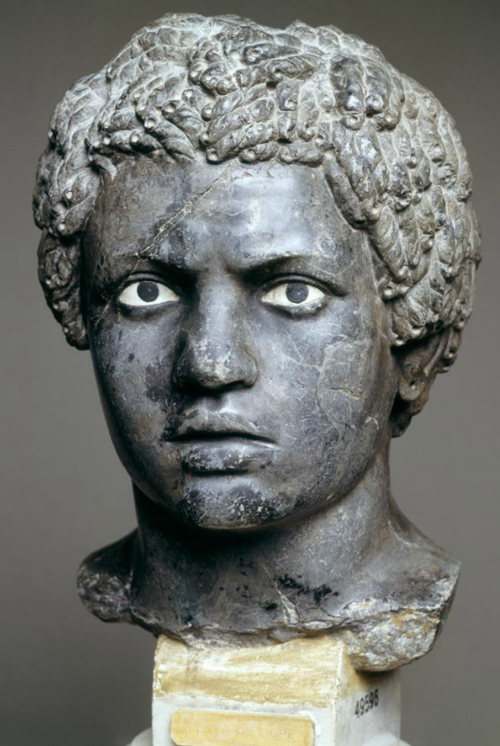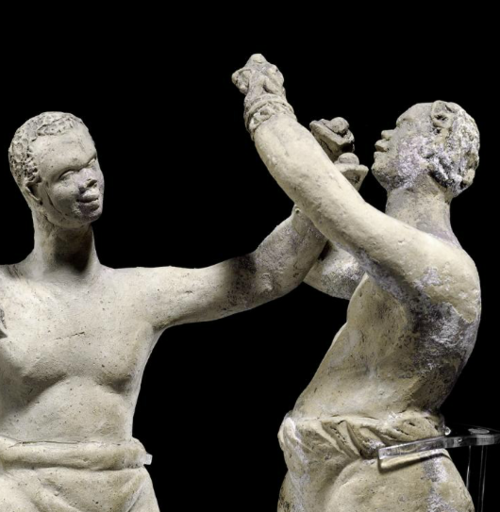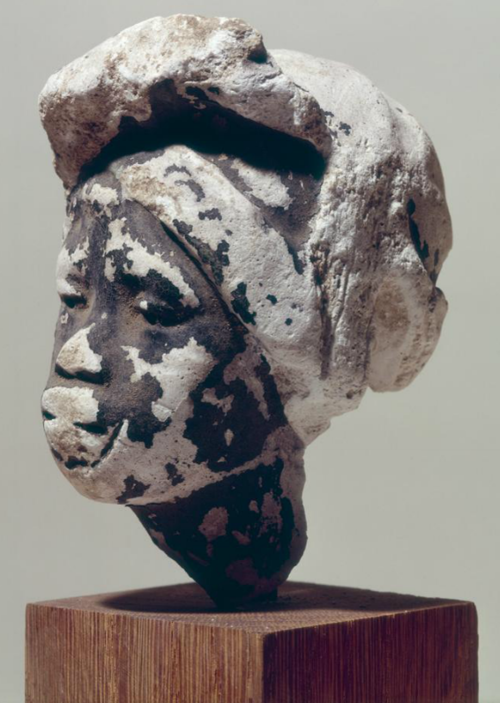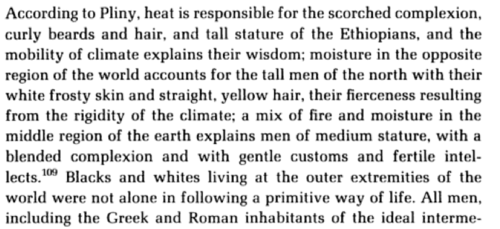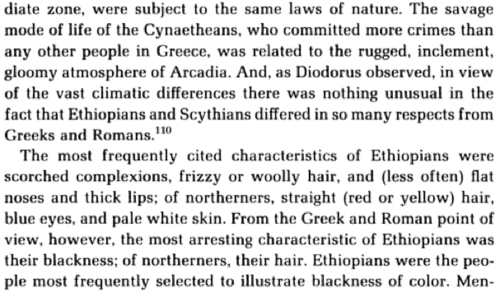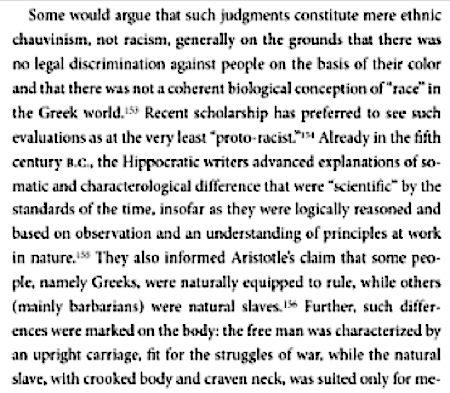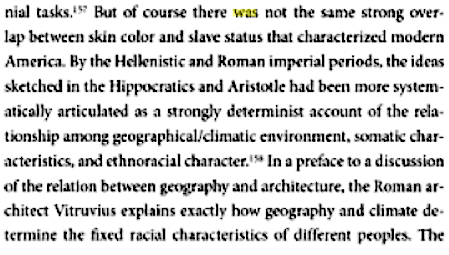Some Central Asian goodness from an American artist:
My Crash Course on the Sogdians book is available on Etsy! Only three little dollars!
Here’s my boilerplate blurb in the Etsy listing:
If you’re unfamiliar with the Sogdians but you love history, this is the book for you!
The Sogdians formed a nation of people in…
Tag Archives: silk road

TLDR: The Parthians were the great empire that controlled the ancient Silk Road, with the Roman Empire to its west and China’s Han Empire to its east. We would do well to remember it more.
Ruins of Nisa, Turkmenistan
Nisa, a royal city of the Parthian Empire, was built by Mithridates I (r. 171 BC – 138 BC) and later called Mithradatkert meaning “the city built by” or “the fortress of’ Mithridates”. Its ruins are located in present day Turkmenistan, near the border with Iran. Excavations have revealed mausoleums, shrines, a treasury, inscribed documents and art works such as ivory rhytons, statues and sculptures.
Built in recognition of the Parthian homeland, Nisa became the seat of Parthian culture and style. Although the Parthians ruled primarily from Ctesiphon in present day Iraq, they used Nisa as their royal necropolis. The city consisted of two walled areas: Old Nisa containing the citadel and the temple complex and New Nisa, which contained the town. Much of the artwork, such as sculptures and carvings, adorning the various structure were Greek in style.
The Parthian Empire was the second great Persian Empire, forming after the brief Seleucid rule that arose after Alexander’s defeat of the first Persian Empire, the Achaemenid. The Parthians ruled for almost 500 years, from 247 BC to 224 AD over territory that included all of modern Iran, Iraq and Armenia as well as parts of Turkey, the Caucasus, Central Asia and, at the height of their reign, territories in Pakistan, Syria, and the Palestine. The Parthian Empire was a multi-ethnic and multilingual society with a rich culture producing great achievements in architecture, art, literature, commerce, and most notably, in military tactics.
The great military prowess of the Parthians was most evident in their battles against the Romans, who considered the Parthians their primary enemy. The Romans, in their conquest for further expansion, fought many battles with the Parthians near the Euphrates River, the natural border between the two empires. These battles persisted for more than two centuries until a final defeat of the Romans by the Parthians in 218 AD.
During the rule of the Parthian Empire, the Chinese for the first time emerged as an Empire, the Han Dynasty, and initiated contact with the outside world. The Parthian and Chinese enjoyed a relationship based on commerce rather than conquest, which ultimately led to the birth of the Silk Road. The Chinese greatly desired Parthian horses and skilled cavalry while the Iranians sought luxury goods, especially pearls and silk. The Silk Road later expanded trade to the Mediterranean basin.
The Parthian Empire was ultimately defeated from internal conflict leading to the establishment of the third Persian Empire, the Sasanian, which arose from south western Iran.
Hi, i don’t know if this is too early for you, but is there any record of free black people in Roman times, specifically pre-empire? My father was saying that it was “very unlikely” for it to have been, but i think otherwise.
*sigh*
This is just another example of the overwhelmingly pervasive idea in our culture that no matter where or when you go in history, anyone who wasn’t Black and who SAW a Black person immediately thought, “Hey! Thisperson and everyone on earth who looks anything like them would make great slaves!” So…before we play remedial education, can we all take a moment to think about how horrible that is? That the idea of Black people=slaves is SO dominant that we project it into ancient history???
Okay, first of all, slavery in the Ancient Mediterranean was not the same as American chattel slavery. It was not race-based slavery. Your race had nothing to do with whether or not you were enslaved.
Basically, what you’re asking about (roughly) is the Hellenistic Era.
After Alexander the Great’s ventures in the Persian Empire, Hellenistic kingdoms were established throughout south-west Asia (Seleucid Empire, Kingdom of Pergamon) and north-east Africa (Ptolemaic Kingdom).
This resulted in the export of Greek culture and language to these new realms, and moreover Greek colonists themselves.
Equally, however, these new kingdoms were influenced by the indigenous cultures, adopting local practices where beneficial, necessary, or convenient. Hellenistic culture thus represents a fusion of the Ancient Greek world with that of the Near East, Middle East, and Southwest Asia, and a departure from earlier Greek attitudes towards “barbarian” cultures.
The Hellenistic period was characterized by a new wave of Greek colonization (as distinguished from that occurring in the 8th–6th centuries BC) which established Greek cities and kingdoms in Asia and Africa. Those new cities were composed of Greek colonists who came from different parts of the Greek world, and not, as before, from a specific “mother city”.
As explained above, what you would have had is a “melting pot” of many different languages, “races”, cultures, schools of art, ethnicities, et cetera.
The art of this period reflects that.
Greek architects and sculptors were highly valued throughout the Hellenistic world. Shown on the left is a terra-cotta statuette of a draped young woman, made as a tomb offering near Thebes, probably around 300 BCE. The incursion of Alexander into the western part of India resulted in some Greek cultural influences there, especially during the Hellenistic era. During the first century BCE., Indian sculptors in Gandhara, which today is part of Pakistan, began to create statues of the Buddha. The Buddhist Gandharan style combined Indian and Hellenistic artistic traditions, which is evident in the stone sculpture of the Buddha on the right. Note the wavy hair topped by a bun tied with a ribbon, also a feature of earlier statues of Greek deities. This Buddha is also wearing a Greek-style toga.
–Essential World History by Duiker, Spielvogel, p. 101
As for trade routed in the Ancient World, well. The Silk Road has existed for pretty much as long as the continents have been in their current configuration and populated by humanity. I’m not exaggerating-the prehistoric version of what became known as the Silk Road is known as The Steppe Road. The Silk Road ITSELF was established for trading purposes at least 2,000 years ago. Here’s a mockup of the Silk Road as it existed during the era you’re asking about:
Here are some Hellenistic Era Greek artworks that feature Black people. There is NO correlation in this era between a person being Black and a person being enslaved.
In general, Greek attitudes towards anyone with Black or dark brown skin were sort of ethnocentric, but not negative OR associated with slavery. After all, the idea of “white people” wouldn’t exist for another 1,500 years at LEAST.
Before Color Prejudice: The Ancient View of Blacks by Frank M. Snowden contains many, MANY invaluable interpretations and translations of primary sources that help to really explore attitudes and philosophies that the people in the time had about appearance, human difference, and personality traits. From page 86:
If you want something a bit more definitive, The Image of the Black in Western Art Vol. 1:From the Pharaohs to the Roman Empire explores the Greek and Roman preoccupation with physical type+personality traits as a form of PROTO-racism, but please note that nothing in their writing or art indicated the association of Blackness or Black skin with slaves or enslavement/enslavability:
“Race” as we have this concept today did not exist then. the “races” they are talking about have to do with ethnicity and culture, NOT skin color by necessity. In addition, the “proto-racist” writing is describing geographical origin and climate to correlate with personality type, with the “perfect balance” being conveniently, Greeks.
As for the beginnings of the Roman Empire, the above is wehre you’re pretty much starting from, and then you have EVEN MORE intermixing between peoples. Including the Emperor born in the Roman Province of “Africa”, Septimius Severus, who led a campaign of additional conquering there around 200 C.E.
He then of course sent tens of thousands of Roman soldiers up directly into Britain and Scotland, and there are extensive records of Black military legions at Hadrian’s Wall in the 3rd century. Incidentally, leading to a rather multicultural population in Roman York (England), which is also extensively documented (Ivory Bangle Lady, one of the richest women in that area at that time, was definitely of African descent).
This would have been the Roman Empire about 100-200 years before the time of Ivory Bangle Lady. Excavations in the area combined with the cutting edge of academia and science combined have this to say:
“We’re looking at a population mix which is much closer to contemporary Britain than previous historians had suspected,” Hella Eckhardt, senior lecturer at the department of archaeology at Reading University, said. “In the case of York, the Roman population may have had more diverse origins than the city has now.”
Isotope evidence suggests that up to 20% were probably long distance migrants. Some were African or had African ancestors, including the woman dubbed “the ivory bangle lady”, whose bone analysis shows she was brought up in a warmer climate, and whose skull shape suggests mixed ancestry including black features.
“We can’t tell if she was independently wealthy, or the wife or daughter of a wealthy man — but the bones show that she was young, between 18 and 23, and healthy with no obvious sign of disease or cause of death.”
The authors comment: “The case of the ‘ivory bangle lady’ contradicts assumptions that may derive from more recent historical experience, namely that immigrants are low status and male, and that African individuals are likely to have been slaves. Instead, it is clear that both women and children moved across the Empire, often associated with the military.”
Feel free to go tell your dad he’s full of it.
TLDR:
Race as it is most often defined (skin color) is a relatively new concept.
Slavery based on race is an even newer concept.
…
Yet more evidence modern humanity SUCKS.
Well, here’s the thing. A lot of people seem to think it’s “wrong” or “ahistorical” of me to “project modern views of race” onto the past. My point is and always has been that this already happens. The above is just one example of of how this happens, and yet the majority of Americans (and I’m sure people elsewhere as well) believe that race determined status in Classical Antiquity, the Roman Empire, pretty much everywhere and every when.
To the point where it’s like walking into an avalanche uphill trying to say any different. We all owe it to ourselves and everyone else to think about WHY that is.

